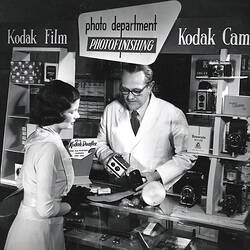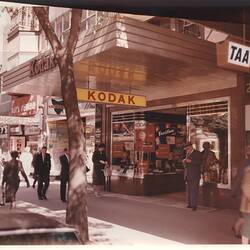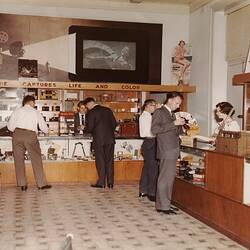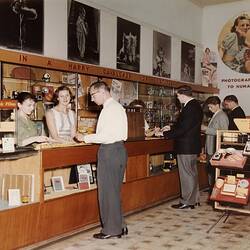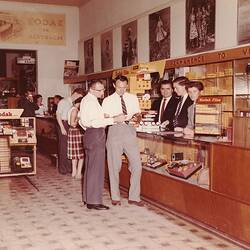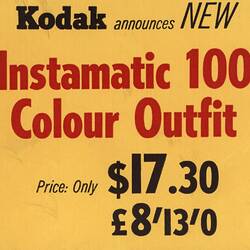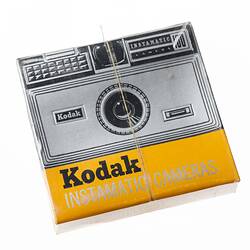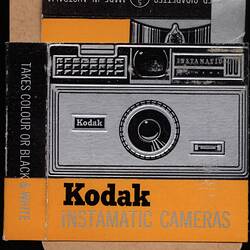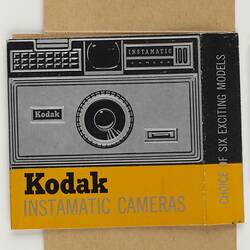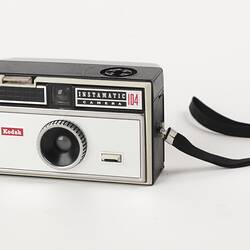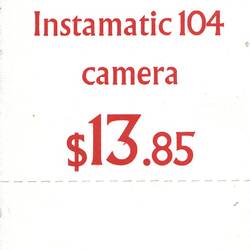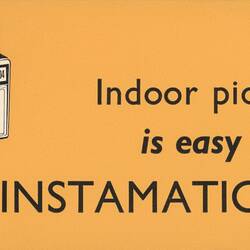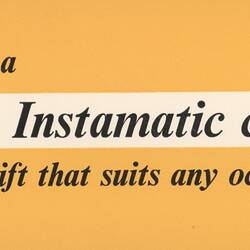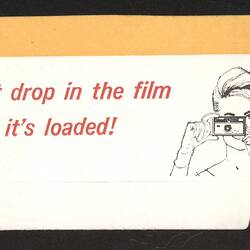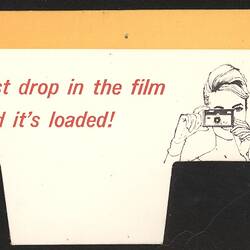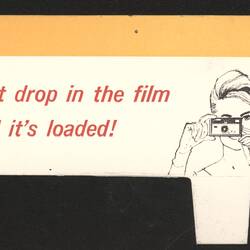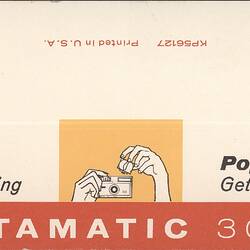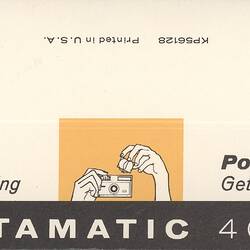Summary
John Harvey's interest in photography prompted him to apply for a job at Kodak. He worked there for 12 years, commencing as a trainee in 1958 and working his way up to Sales Rep and supervisor.
John Harvey, Kodak Australasia Pty Ltd: Trainee and Sales Representative 1958 - 1970
John Harvey's interest in photography prompted him to apply for a job at Kodak Australasia. At the age of 17, he was given a traineeship, commencing in 1958, but he was not quite sure what he would be trained for. It turned out to be sales.
Kodak shop, 252 Collins Street, Melbourne
John's first job was assistant to Jim Morgan on the second-hand counter at Kodak House, Kodak's Collins Street shop. His training involved experience in a variety of positions in his first eighteen months, including a stint in the motion picture department, where he learned to sell movie cameras and splice film. He also served customers on the Kodachrome counter, where customers brought films for processing. Sometimes John delivered the courier bag of films to Kodak's processing plant, taking the tram to Abbotsford. His supervisor on the Kodachrome counter was Audrey Crewther. Romance blossomed and the couple married a few years later.
The Collins Street shop was typical of Kodak shops in Australia of the 1950s and '60s. John describes the interior layout:
"It was very, very long and the counters went down both sides of the shop, and it was a walk through to Howey Place. On the left hand side you had the black and white counter. Black and white was king in those days, and the black and white counter was as long as the main sales counter on the right. Two thirds of the way up the shop there were about three steps, and you went up, and on the left hand side there was the second hand department, and on the right hand was the Kodachrome and colour print department."
Becoming a sales 'rep'
John's next move was to Kodak's Victorian warehouse in La Trobe Street, firstly as assistant to John Shepherd in dealer sales, then as a sales representative, commonly referred to as a 'rep'. John believes he was the youngest sales rep ever employed by Kodak. Since he didn't yet have a drivers licence, he was given Melbourne's CBD his round. 'So my very first call was the biggest retail customer in Victoria, Myer'.
A suburban round followed, and in the early 1960s, John, still a very young man, became a country rep. This, according to John, was 'the prestige job within the reps'. He visited various regions in Victoria, but his main territory was Gippsland. He sold the range of Kodak retail products to camera shops and pharmacists, visiting customers every six weeks. John gives some insights into the life of a travelling rep:
"Basically you were away four nights a week. You'd leave Monday morning and you'd be in a motel or a hotel every night and then you'd have a short day on Friday getting home and going to the meeting in the afternoon and then getting home for the weekend. . We were given a limit in the motel. We couldn't stay at the Menzies or the Hyatt, but we were well treated as far as accommodation.
We were a GMH company. Some of the cars were purchased direct for the country representatives; others were purchased for the directors. The director had the car for twelve months and then passed it onto a country rep. The country rep had his new car for two years or the director's car for one year, then it was passed onto the suburban reps, and then it was traded in on a director's car. So no flashy extras for senior management."
In the 1960s smoking was an accepted part of working and social life, and cigarettes were provided for the reps to offer to customers and as a promotional tool. John was then a smoker:
"We were issued with two hundred cigarettes a week, as part of our award. And that's why I gave up smoking. Because one Monday afternoon I found out I'd smoked all two hundred on the way up to Omeo. I was in on the introduction of the original Instamatic camera, where one of our main support ads was a packet of Capstan cigarettes, which was printed up as an Instamatic. The reason Capstans were supplied was that they didn't have a flip top box, they had the tray and when you pushed the tray open to offer the cigarette, the inside of the tray was the flash gun that popped up. So you had this little image of a flash gun on the leaf, and you offered the cigarette and there was the flash gun ready to run."
According to John, Kodak reps enjoyed more prestige than reps from other companies. He remarked: "many times a rep was asked to wait because Mr Kodak was at the door." After a few years on the road, John became a photo finishing rep, selling Kodak chemicals and papers for developing and printing to small laboratories and professional photographic studios. He was often called upon to solve customers' technical problems. One customer had moved his studio from one Melbourne suburb to another and was finding little dimples all over his glazed prints. John took the problem to the head of Kodak's testing department, and after many hours of work, it was discovered that the difference in the water supply was the cause.
Ending a Kodak career
In 1966 John was promoted to professional commercial industrial market sales supervisor, in charge of two reps. His office was in La Trobe Street. In 1970, after disagreements with senior management John felt that he no longer had a future at Kodak and resigned. However he has positive memories of Kodak as an 'absolutely marvellous company to work for in the early days'. Although there was no commission paid to sales reps, John believes that he was well paid, and he was in Kodak's generous superannuation scheme. Another advantage he enjoyed as a Kodak employee was membership of the company's building society - Yarra Grange Housing Co-operative - which provided low-interest home loans.
After Kodak
Building on his twelve year career at Kodak, John spent the remainder of his working life in the photography industry. He worked in a photo finishing business in Geelong, before running his own mini lab and camera shop in suburban Melbourne for fifteen years. After that he worked for Photowaste Management as a silver recovery technician. He retired in 2004 to care for his wife Audrey, who was stricken with Alzheimer's.
References
Beale, Nigel, 'The History of Kodak in Australia', 1983 (unpublished manuscript).
HT 36972 - Interview with John Harvey, interviewed by Lesley Alves, 15 April 2014.
More Information
-
Keywords
Photographic Products, Retailing, Biographies, Shops, Sales Representatives
-
Authors
-
Article types

